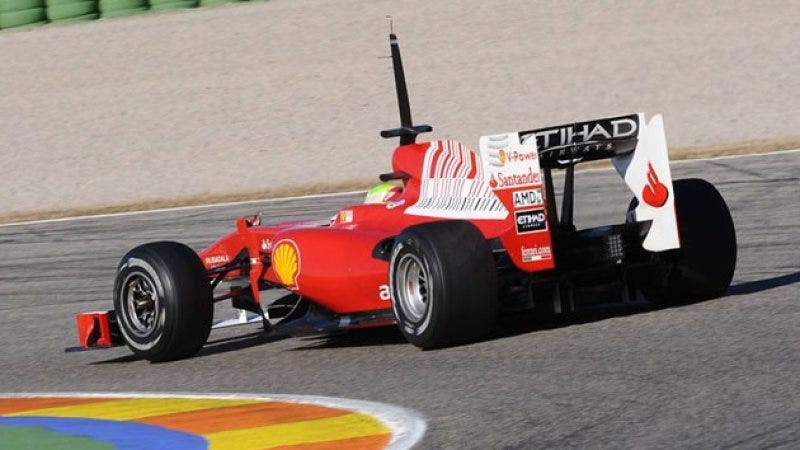Why is this interesting? - Wednesday, April 3
On subliminal advertising, cigarettes, and F1 racing
Noah here. If you read yesterday’s links you saw info about Mission Winnow, a division (I guess you could call it that) of Philip Morris International (PMI) and the main sponsor of Ferrari’s Formula 1 team. Well, since then I’ve been sent a bunch more reading on the strange history of PMI and Ferrari (thanks Nick!). Turns out tobacco and racing has a long history that took a turn in the early 2000s as European countries started regulating, and eventually banning, tobacco advertising. At that time PMI and Ferrari started to find more and more abstract ways to display the Marlboro branding, peaking in 2008, when they drove with a red, black, and white barcode that looked a lot like a bunch of cigarettes/the Marlboro logo stretched out.

Why is this interesting?
In 2010 the team took heat when British doctors accused Ferrari and PMI of subliminal advertising. “The barcode looks like the bottom half of a packet of Marlboro cigarettes,” explained John Britton, a fellow of the British Royal College of Physicians and director of its tobacco advisory group. “I was stunned when I saw it. This is pushing at the limits. If you look at how the barcode has evolved over the last four years, it looks like creeping branding.”
The Ferrari team responded pretty defensively to the allegations:
“Neither of these arguments have any scientific basis, as they rely on some alleged studies which have never been published in academic journals. But more importantly, they do not correspond to the truth. The so called barcode is an integral part of the livery of the car and of all images coordinated by the Scuderia [the name of the Ferrari team], as can be seen from the fact it is modified every year and, occasionally even during the season. Furthermore, if it was a case of advertising branding, Philip Morris would have to own a legal copyright on it.”
Later that year the team was pushed to remove the barcode by the sports governing body, but that didn’t end the sponsorship. PMI extended the deal in 2011 and again in 2015, despite agreeing to remove the Marlboro name from it’s Scuderia Ferrari Marlboro moniker in the years in between. As far as I can tell, in 2018 Mission Winnow came on the scene with a logo full of chevrons, a bunch of Tweets that read like motivational posters, and a very vague mission:
“Mission Winnow has a simple goal: drive change by constantly searching for better ways of doing things. From world-leading engineers and scientists to cutting-edge creatives, the people at PMI, and our partners at Scuderia Ferrari and Ducati, have the know-now to challenge the status quo, drive revolutionary change and to be champions.”
Not shockingly, folks are still pretty suspicious. A February 2019 editorial from BMJ, a peer-reviewed medical journal out of Britain, suggested that this looks a lot like the same old behavior. “It appears that the Mission Winnow campaign is based on similar arguments relating to the Ferrari barcode design in 2010. Mission Winnow appears to be using the power of persuasion and their history of both active and subliminal advertising of Marlboro in F1 and MotoGP to continue promoting this association.” Apparently Australian authorities are investigating whether it’s just an attempt to get around tobacco advertising bans.
In the end the real question is what is PMI doing? Seems to me there are two possible explanations: either it’s true that the Marlboro brand is so strong that all they need is some shapes and colors in red, black, and white to deliver meaningful brand impressions (not an unreasonable thesis) or there’s an executive at PMI that loves going to F1 races enough that they’re happy to waste hundreds of millions of dollars to make that dream a reality (also not unreasonable). In the end I would guess it’s a little of column a and a little of column b, which makes for one of the strangest stories I’ve ever encountered in marketing. (NRB)
Quick Links
Google+ is shutting down today. Good chance to re-read the post by a Google engineer who accidentally posted an anti-G+ manifesto publicly. “Google+ is a knee-jerk reaction, a study in short-term thinking, predicated on the incorrect notion that Facebook is successful because they built a great product,” he wrote in 2011. (NRB)
An analysis of where Apple Store as community hub went wrong and was a super misguided strategy. (CJN)
New York finally has a congestion pricing plan in place. Set to launch in 2021, “drivers would be charged for entering Manhattan below 60th Street, where the average speed for vehicles is down to 4.7 miles per hour, from 6.9 miles per hour in 1994.” 4.7 miles per hour! (NRB)
Purdue Pharma, the company behind Oxycontin, is looking for an advertising agency to help with a new drug launch … Any takers? (NRB)
There’s a big Forbes feature in VC firm Andreessen Horowitz, who apparently are going to stop being a VC (in the legal sense) so they can take riskier bets without having to build walls between the different funds, as they apparently had to when they raised a crypto fund that had to have a different legal entity and its own email addresses. “The firm renounced its VC exemptions and registered as a financial advisor, with paperwork completed in March. It’s a costly, painful move that requires hiring compliance officers, audits for each employee and a ban on its investors talking up the portfolio or fund performance in public—even on its own podcast. The benefit: The firm’s partners can share deals freely again, with a real estate expert tag-teaming a deal with a crypto expert on, say, a blockchain startup for home buying, Haun says.” (NRB)
The Tim Kennedy workout. (CJN)
Thanks for reading,
Noah (NRB) & Colin (CJN)


